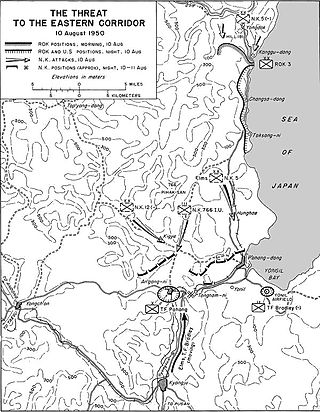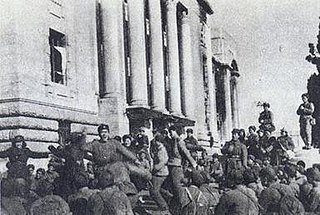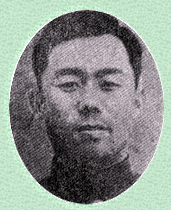
The Battle of Chosin Reservoir, also known as the Chosin Reservoir Campaign or the Battle of Lake Changjin, was an important battle in the Korean War. The name "Chosin" is derived from the Japanese pronunciation "Chōshin", instead of the Korean pronunciation.

The People's Volunteer Army (PVA), officially the Chinese People's Volunteers (CPV), was the armed expeditionary forces deployed by the People's Republic of China during the Korean War. Although all units in the PVA were actually transferred from the People's Liberation Army (PLA) under the orders of Chairman Mao Zedong, the PVA was separately constituted in order to prevent an official war with the United States. The PVA entered Korea on 19 October 1950 and completely withdrew by October 1958. The nominal commander and political commissar of the PVA was Peng Dehuai before the ceasefire agreement in 1953, although both Chen Geng and Deng Hua served as the acting commander and commissar after April 1952 following Peng's illness. The initial units in the PVA included 38th, 39th, 40th, 42nd, 50th, 66th Corps; totalling 250,000 men. About 3 million Chinese civilian and military personnel had served in Korea throughout the war.

The 766th Independent Infantry Regiment was an elite light infantry unit of North Korea's Korean People's Army (KPA) that existed briefly during the Korean War. It was headquartered in Hoeryong, North Korea, and was also known as the 766th Unit. Trained extensively in amphibious warfare and unconventional warfare, the 766th Regiment was considered a commando unit. The regiment was trained to conduct assaults by sea and then to lead other North Korean units on offensive operations, to infiltrate behind enemy lines, and to disrupt enemy supplies and communications.
The 117th Division was a military formation of the People's Volunteer Army during the Korean War with a standard strength of approximately 10,000 men. It was a component of the 39th Army, consisting of the 349th, 350th, and 351st Regiments.
The 148th Division was a military formation of the People's Liberation Army of the People's Republic of China.
The 52nd Army Division, which consists of the 52nd Mountain Motorized Infantry Brigade and the 52nd Mountain Combined Arms Brigade, was originally the 149th Division. It is an infantry formation of the People's Liberation Army of the People's Republic of China, and is currently a mountain unit stationed near India.
The 150th Division, then 11th Garrison Division of Shenyang Military Region was a military formation of the People's Liberation Army of the People's Republic of China.
The 197th Army Division, then 5th Garrison Brigade of Beijing Military Region was a military formation of the People's Liberation Army of the People's Republic of China.
The 88th Division was a military formation of the People's Volunteer Army during the Korean War. They were a component of the 30th Army. The 88th Division was assigned as a reinforcing Division to the 26th Army.

The Battle of Onjong, also known as the Battle of Wenjing, was one of the first engagements between Chinese and South Korean forces during the Korean War. It took place around Onjong in present-day North Korea from 25 to 29 October 1950. As the main focus of the Chinese First Phase Offensive, the People's Volunteer Army (PVA) 40th Corps conducted a series of ambushes against the Republic of Korea Army (ROK) II Corps, effectively destroying the right flank of the United States Eighth Army while stopping the UN advance north toward the Yalu River.

The Battle of Wawon(Korean: 군우리 전투; hanja: 軍隅里戰鬪; rr: Gunuri Jeontu; Turkish: Kunu-ri Muharebesi), also known as the Battle of Wayuan, was a series of delay actions of the Korean War that took place from 27–29 November 1950 near Wawon in present-day North Korea. After the collapse of the US Eighth Army's right flank during the Battle of the Ch'ongch'on River, the Chinese People's Volunteer Army (PVA) 38th Corps advanced rapidly towards the critical road junction at Kunu-ri in an effort to cut off United Nations forces' retreat route. In what was considered to be Turkey's first real combat action since the aftermath of World War I, the Turkish Brigade attempted to delay the Chinese advances at Wawon. Although during the battle the Turkish Brigade was crippled after being encircled by Chinese forces with superior numbers, they were still able to breach the Chinese trap and rejoin the US 2nd Infantry Division. Delay of the PVA advance after meeting with heavy Turkish resistance helped the other United Nations forces to withdraw without suffering many casualties and reassemble later in December.

The Battle of the Ch'ongch'on River, also known as the Battle of the Ch'ongch'on, was a decisive battle in the Korean War that took place from November 25 to December 2, 1950, along the Ch'ongch'on River Valley in the northwestern part of North Korea. In response to the successful Chinese First Phase Campaign against the United Nations (UN) forces, General Douglas MacArthur launched the Home-by-Christmas Offensive to expel the Chinese forces from Korea and to end the war. Anticipating this reaction, the Chinese People's Volunteer Army (PVA) Commander Peng Dehuai planned a counteroffensive, dubbed the "Second Phase Campaign", against the advancing UN forces.

The Third Battle of Seoul was a battle of the Korean War, which took place from December 31, 1950, to January 7, 1951, around the South Korean capital of Seoul. It is also known as the Chinese New Year's Offensive, the January–Fourth Retreat or the Third Phase Campaign Western Sector.

The First and Second Battles of Wonju, also known as the Wonju Campaign or the Third Phase Campaign Eastern Sector, was a series of engagements between North Korean and United Nations (UN) forces during the Korean War. The battle took place from December 31, 1950, to January 20, 1951, around the South Korean town of Wonju. In coordination with the Chinese capture of Seoul on the western front, the North Korean Korean People's Army (KPA) attempted to capture Wonju in an effort to destabilize the UN defenses along the central and the eastern fronts.

This is the order of battle for Chinese People's Volunteer Army during major periods of hostilities in the Korean War. After the People's Republic of China entered the Korean War in October 1950 by designating the People's Liberation Army (PLA) North East Frontier Force as the People's Volunteer Army (PVA), the PVA spent the next two years and nine months in combat operations and five years and three months in garrison duties. Its last elements did not leave Korea until as late as 1958.

Kang Kon was a Korean military leader active in Manchuria and the Korean peninsula as well as a politician during the years leading up to the Korean War and during the first stages of the Korean War in 1950.
The III Corps is a corps of the Korean People's Army. It was created just before the North Korean invasion of 1950 with Lt. General Yu Kyong-su in command. During the initial North Korean invasion of the south, it was in reserve, comprising the 10th Infantry Division, the 13th Division, and the 15th Infantry Division.









